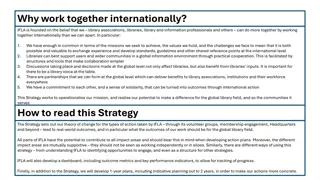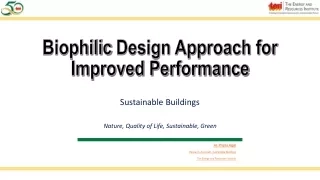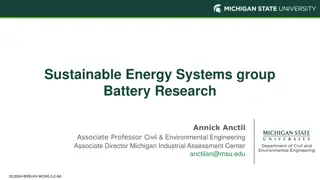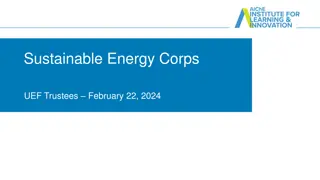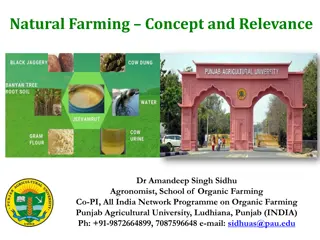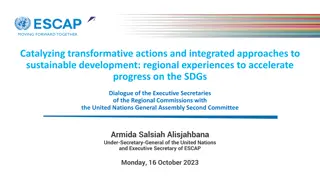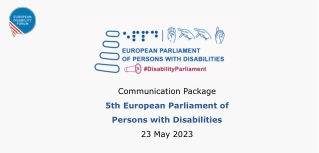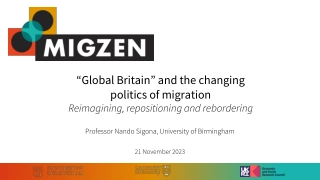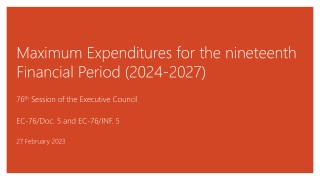Energizing Parliaments for Sustainable Futures
Explore India's energy initiatives at the 66th Commonwealth Parliamentary Conference in Accra. Learn about SAUBHAGYA, PM-KUSUM, and India's commitment to clean, accessible, and affordable energy transitions. Discover the role of parliaments in ensuring energy sustainability and efficiency worldwide.
Download Presentation
Please find below an Image/Link to download the presentation.
The content on the website is provided AS IS for your information and personal use only. It may not be sold, licensed, or shared on other websites without obtaining consent from the author. Download presentation by click this link. If you encounter any issues during the download, it is possible that the publisher has removed the file from their server.
Presentation Transcript
66th Commonwealth Parliamentary Conference Accra, Ghana 30 September - 6 October 2023 Hon ble Chairperson and Distinguished Delegates
Aim Parliaments across the Commonwealth, must seek to ensure and secure reliable, efficient, affordable and environmentally sustainable energy provision that are available to all. Even as the global GDP crossed the $ 100 trillion mark in 2022, nearly 750 million people continue to live in energy poverty, without any electricity access, mainly in African and Asian countries. During India s Presidency of G20 this year, The Global Biofuel Alliance was launched to facilitate the adoption of biofuels by bringing together the biggest consumers and producers of biofuels. GBA showcases the action-oriented nature of India. During the Indian Presidency of G20, the African Union is now the 21st member of the G20. India has emerged as a champion, voicing the concerns of the Global South. One Earth, One Family, One Future .
Indias Energy Agenda The Indian Parliament is continuously engaging in legislative actions to drive energy policy initiatives, revamp policies , and implement necessary measures to eliminate energy poverty. India commits to accelerating clean, sustainable, just, affordable and inclusive energy transitions as a means of enabling strong and balanced growth to achieve our climate objectives. India is developing policies based on the five guiding key enablers - Energy availability Energy accessibility Energy affordability Energy sustainability Energy efficiency
India, Leads By Example Saubhagya: (Meaning Good Luck in English) Pradhan Mantri Sahaj Bijli Har Ghar Yojana (Saubhagya), is the largest expansion of energy access anywhere in the world. Under this initiative, the electrification of all villages and households was completed by 31st March, 2019. SAUBHAGYA initiative has provided electricity connections to 28.6 million unconnected households since September 25, 2017. Another scheme, the Deen Dayal Upadhyaya Gram Jyoti Yojana (DDUGJY) has accomplished electrification of 18,000 villages, ensuring complete electricity access.
India, Leads By Example PM-KUSUM (Pradhan Mantri Kisan Urja Suraksha Utthan Mahabhiyan) It is the worlds largest clean energy initiative for the agriculture sector with an objective to solarize agriculture pumps of almost 3.5 million farmers. It aims to convert them from consumers to prosumers. This scheme provides energy and water security, de-dieselizes the farming sector, generates additional income for farmers by producing solar power. Supported installation of 135.08 MW of small solar power capacity and the deployment of 260,000 standalone and grid-connected agriculture pumps with financial support of over $4 billion from the central government. The scheme consists of three components: Component A: Installation of 10,000 MW of decentralized grid connected solar power plants, each with a capacity up to 2 MW. Component B: Setting up of 2 million standalone solar powered agriculture pumps. Component C: Solarization of 1.5 million existing grid-connected agriculture pumps. In my constituency Jhansi, under Kusum 2 , we are installing another 10 thousand solar panels for agricultural and domestic use.
India, Leads By Example Ujjwala Scheme A flagship scheme with an objective to make clean cooking fuel such as Liquified Petroleum Gas (LPG) available to the rural and deprived households which were otherwise using traditional cooking fuels such as firewood, coal, cow-dung cakes etc. Usage of traditional cooking fuels had detrimental impacts on the health of rural women as well as on the environment. Beneficiaries will receive free connections along with the first cylinder without any charge. A 200 ($ 2.5) decrease in the cost of domestic LPG cylinders for all consumers. The release of 96 million LPG connections under the scheme has also helped in increasing the LPG coverage from 62% to 99.8%
India, Leads By Example Unnat Jyoti (meaning Improved Light ) & UJALA ( Bright Light ) The Unnat Jyoti was launched in 2015, with a target of replacing 770 million incandescent lamps with subsidised and affordable LED bulbs. The scheme was introduced to overcome the previous issue of high LED costs, hindering the adoption of energy-efficient systems. It aimed to gradually distribute LED bulbs nationwide, making them affordable and accessible to the public. The procured price of LED bulbs decreased by almost 90% between 2014 and 2019, from $3.72 to $0.48. More than 3,820 million LED bulbs have been distributed so far under this scheme, resulting in carbon emission reduction of 38 million tonnes CO2 per year.
India, Leads By Example Key Achievements Of Energy Efficiency In India India s Long Term Low Emissions Development Strategy (LT-LEDS) focus on low carbon development choices; rational utilization of national resources, energy security and achieving Net Zero by 2070 . Roadmap of Sustainable and Holistic Approach to National Energy Efficiency (ROSHANEE) under NAPCC revamped National Mission on Enhanced Energy Efficiency includes expanding coverage of Perform Achieve Trade (PAT) scheme; developing a PAT for SMEs, promote Energy Service Companies (ESCOs), mobilize investment, enhancing state- level capacity building. PAT CO2 emission reduction in 13 energy intensive sector energy savings of ~24 MTOE = 106 MTCO2 emission reduction. iDEEKSHA portal for all energy efficiency and decarbonization needs of energy-intensive industries. Voluntary Star Labeling Programme for electrical appliances expected to save approx. 11.2 billion electricity units by 2030 reduction of CO2 emission close to 9 MT by 2030.
Jhansi Case Study Projects Solar parks and usage of solar panels on Govt. & Institutional buildings- Rooftop Solar Panels are being installed on Government and Institutional Buildings which are Highly efficient Maintenance free Cost effective Eco-friendly Up gradation and renovation of Jhansi District Library - Fastest constructed Library of India in just 90 days. The energy demands of the Library are fulfilled from the Solar and Wind Energy systems, installed in the building. Air Conditioned with water-based, radiant flow cooling technology. Net Zero Carbon emission by reducing 90 percent energy consumption.
Jhansi Case Study Projects Centralized Control & Monitoring System for Existing Street Lights - Built on energy saving lighting system with integrated sensor. All LED streetlights are switched ON/OFF through computer sensors. Economically affordable and energy saving project. Complaints are redressed from a centralized control command center. Errors that might occur due to manual operations are eliminated. Waste to Energy Proposed Plant To utilise 300 ton of City Municipal waste Wet garbage/ trash to produce steam to be used to power electric generator turbine. For every 100 pounds of solid waste, about 85 pounds can be burnt as fuel to generate electricity. Reduces volume of waste by about 87%
Jhansi Case Study Canal-top Solar Power Plant Located in Jakhlaun in Lalitpur District First-of-its-kind canal-top solar plant which supplies GREEN electricity. Aids Water conservation, reduces water evaporation. Improves panel efficiency as running water cools solar panels Grid interconnectivity. Cost effective project. Mitigates about 7500 tons of carbon emission per year Provides water for irrigation to 50,000 farmers without relying on grid power
Key Achievements India Cooling Action Plan (ICAP) reduction of cooling demand, refrigerant transition, enhancing energy efficiency, better technology options by 2037-38 reduction of cooling energy requirements by 25-40% by 2037-38. National Solar Mission under NAPCC India s installed solar energy capacity stands at 71.61 GW as of 31st August 2023. India s renewable capacity is about 180 GW India submitted a very ambitious NDC to UNFCCC in 2015 to achieve 40% cumulative electric power installed capacity from non fossil based energy sources by 2030 and managed to do this by 2021. During COP 26, Hon ble PM has committed that India shall become zero carbon by 2070 Rooftop Solar Photovoltaic (PV) Programme Phase II of the Rooftop Solar Programme extended up to 31st March 2026 National portal developed any residential consumer from any part of the country can apply for rooftop solar without waiting for Discom to finalize the tender and empanel vendors
Key Achievements National Green Hydrogen Mission outlay of $ 2.5 billion from FY 2023-24 to FY 2029-30 annual production of 5 MMT by 2030 expected to reduce a cumulative $ 12.5 billion worth of fossil fuel imports by 2030 expected to avert nearly 50 MMT per annum of CO2 emissions Green Grids Initiative - One Sun, One World, One Grid worldwide grid - availability of clean energy, everywhere, at all times reducing need for storage, carbon footprint, cost of energy and increase in viability of solar projects
Long-term Sustainability Sector-wise Achievement as on 31/08/2023 Under Implementation (GW) 71.61 44.09 10.83 4.98 Total Installed/ Pipeline (GW) Sector Installed capacity (GW) Tendered (GW) Solar Power* Wind Power Bio Energy# Small Hydro Hybrid/ Round the Clock (RTC)/ Peaking Power/ Thermal + RE Bundling Sub Total Large Hydro Total Nuclear Total Non-Fossil Fuel 63.91 12.28 22.94 1.30 158.46 57.67 10.83 5.51 --- --- --- 0.53 --- --- 17.78 17.78 131.51 46.85 178.36 7.48 185.84 76.72 $18.03 94.75 42.02 250.25 64.88 315.13 7.48 322.61 -- 42.02 -- -- 94.75 42.02
Long-term Sustainability As per CEA s report on optimal generation capacity mix for 2029-30 , likely installed capacity of various non-fossil energy sources by the end of 2029-2030 would be as given in the table below: Source Solar Wind Small Hydro Biomass Hydro PSP Nuclear Total (RE+ Nuclear) Others (coal, gas etc.) Total (All sources) Battery Energy Storage Likely Capacity (MW) 2,80,155 1,40,000 5,000 10,000 60,977 10,151 18, 980 5,15,112 2,91,991 8,17,254 27,000 Percentage Mix (%) 34.28 17.13 0.61 1.22 7.46 1.24 2.32 64.26 35.74 100 --
Our future plans & commitments to energy poverty alleviation Bio - Fuel Virtually any biological material like grass, crops, municipal and animal waste, and agricultural waste can be used to constitute biofuel which offers an alternative to fossil fuels. Bio-Agro (Ethnol) Resources - Bioethanol is a high-octane number biofuel which is produced from fermentation of corn, potatoes, grain (wheat, barley and rye), sugar beet, sugar cane and vegetable residues. Gobar Dhan (Cow dung)- is a vital umbrella initiative of Government of India, based on the whole of Government approach and aims to convert waste to wealth towards promoting circular economy. Government of India intends to build a robust ecosystem for setting up Biogas/Compressed Biogas (CBG)/ Bio-Compressed Natural Gas (CNG) plants to drive sustainable economic growth and promote a circular economy.
Our future plans & commitments to energy poverty alleviation
Conclusion India was selected as Global Champion on Energy Transition on 24 September 2021 by the United Nations Dialogue on energy transition presents India with an opportunity to share experiences with the entire world. To attain Sustainable Development Goals 7 (SDG7) concerted actions are required all across the world, in the same spirit especially those in positions of privilege to work ambitiously to support a global energy transition. India will finalize its energy compacts going forward based on its target of 450 GW renewable energy capacity by 2030. These will be primarily focused upon solar, wind and bio-energy; storage systems, green hydrogen and international cooperation through the International Solar Alliance. The initiative of One Sun, One World, One Grid put forth by Hon. PM Modi at first assembly of International Solar Alliance is aimed at interconnected solar energy infrastructure at a global scale. Besides bringing synergies to national efforts, it will create millions of green jobs. Global Bio-Fuels Alliance It is an initiative to develop an alliance of governments, international organizations and industry to facilitate adoption of biofuels by bringing together the biggest consumers and producers of biofuels and positioning biofuels as a key to energy transition. This alliance brings together biofuel producers and consumers to strengthen trade and help nations meet their emission reduction targets and enable their energy transition away from fossil fuels. It's goals include ensuring energy security, affordability, and access to cleaner fuels.














